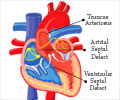Highlights
- Scientists from Gladstone Institute of Cardiology have identified a single mutation in GATA4 gene that is found to lead to two different heart diseases.
- A hole in the septum of the heart is found in newborns and in adolescents, there is heart muscle dysfunction.
- Study provides key insight into developmental stages of the heart as well as mediators of heart function
A mutation in the GATA4 (GATA Binding Protein 4) gene results in a hole in the septum of the heart that separates the two chambers. This gene affects the production of the protein called GATA4, which is considered a master regulator as this protein silences or activates other genes that are involved in the development of the heart.
Congenital Heart Defects
A congenital heart defect is a condition that exists from birth. They are the leading cause of non-infectious mortality among newborns with a prevalence of 4 to 8 per 1000 live births. A serious defect among newborns may be identified by the following symptoms:
- A bluish tint called cyanosis in the fingernails, lips and the skin
- Fast breathing
- Tiredness
- Poor blood circulation
Dr. Srivastava first met the family in 2003, when they approached him with septal defects in nearly half of the babies born in their family. This lead the doctor to initiate gene sequencing practices that were used to identify the mutations that lead to this congenital disorder. In all the family members with this disorder, it was found that there was a single gene mutation in GATA4.
GATA4 Gene Mutation in Action
The scientists used stem cell technology to reprogram the cells and convert them into beating heart cells. This led to the development of heart cells with the genetic mutation that was identified in the family, providing first-hand information about how the gene influences heart development and function.
There were many abnormalities that were identified and they included
- The cells began to beat weaker than in normal heart cells.
- The mutation was also found to affect the functioning of genes that were involved in the formation of the heart, especially the ones that were involved in the development of the septum.
- The genes that were involved in the development of other organs were turned on when they were supposed to be turned off. This highlights the function of the GATA4 gene in activating and silencing other important genes.
- The mutation in GATA4 prevented the activity of the protein TBX5 from including genes for heart function and contraction. GATA4 and TBX5 work together in activating and silencing genes that were involved in heart function and development. A deficiency in one protein, affects the functioning of the other protein as well. The mutation in TBX5 has also been found to lead to the development of a hole in the septum.
While talking about the far reaching effects of this study, Dr. Srivastava said, "By studying the patients' heart cells in a dish, we were able to figure out why their hearts were not pumping properly. Investigating their genetic mutation revealed a whole network of genes that went awry, first causing septal defects and then the heart muscle dysfunction."
This study supports the previous studies conducted on the effect of GATA4 gene mutation and heart defects. In the study conducted by Dr. Tomita Mitchell and colleagues titled GATA4 sequence variants in patients with congenital heart disease (2007) it was found that GATA4 gene mutation was associated with a percentage of septal defects in the heart and also among people with conotruncal defects.
In a study titled Congenital heart disease-causing Gata4 mutation displays functional deficits in vivo, conducted by Misra C and colleagues, it was found that mutation in the GATA4 gene affected cardiomyocyte proliferation during embryogenesis that leads to congenital heart defects.
Drug Target
The GATA4 protein is an important protein that influences the development of the heart and other organs and, therefore, it cannot be directly targeted. There are downstream elements to the protein which could be potential targets of therapy.
The studies conducted by the scientists from Gladstone Institute of Cardiology identified a cluster of genes that were involved in the development of the heart. The network of such genes could be targets for therapy to lower the damages caused by the mutation in GATA4 gene. The researchers claim that there are drugs that are available and which can now be used to modify the downstream elements for congenital heart disease patients.
References:
- Congenital Heart Defects - (https://medlineplus.gov/congenitalheartdefects.html)
- Congenital heart disease-causing Gata4 mutation displays functional deficits in vivo - (https://www.ncbi.nlm.nih.gov/pubmed/22589735)
- GATA4 sequence variants in patients with congenital heart disease - (https://www.ncbi.nlm.nih.gov/pmc/articles/PMC2652815/)















